Torrens University: MIS501 Use Case Diagram Peer Assessment Report
VerifiedAdded on 2022/10/01
|6
|1338
|108
Report
AI Summary
This report presents a peer assessment of a use case diagram designed for a university's enrollment and timetable system. The assessment critically analyzes the diagram's accuracy and completeness in representing the system's functionalities, including student enrollment, class scheduling, and staff allocation. The report identifies several issues, such as missing use cases for student subject selection and enrollment, incorrect associations between actors and use cases, and the absence of 'include' and 'extend' relationships. The assessment also highlights the need for clearer roles and responsibilities, particularly concerning the program director and timetabling manager. The report suggests improvements to the diagram, emphasizing the inclusion of all relevant actors and use cases to accurately reflect the system's requirements, and offers recommendations for enhancing the clarity and effectiveness of the use case diagram.
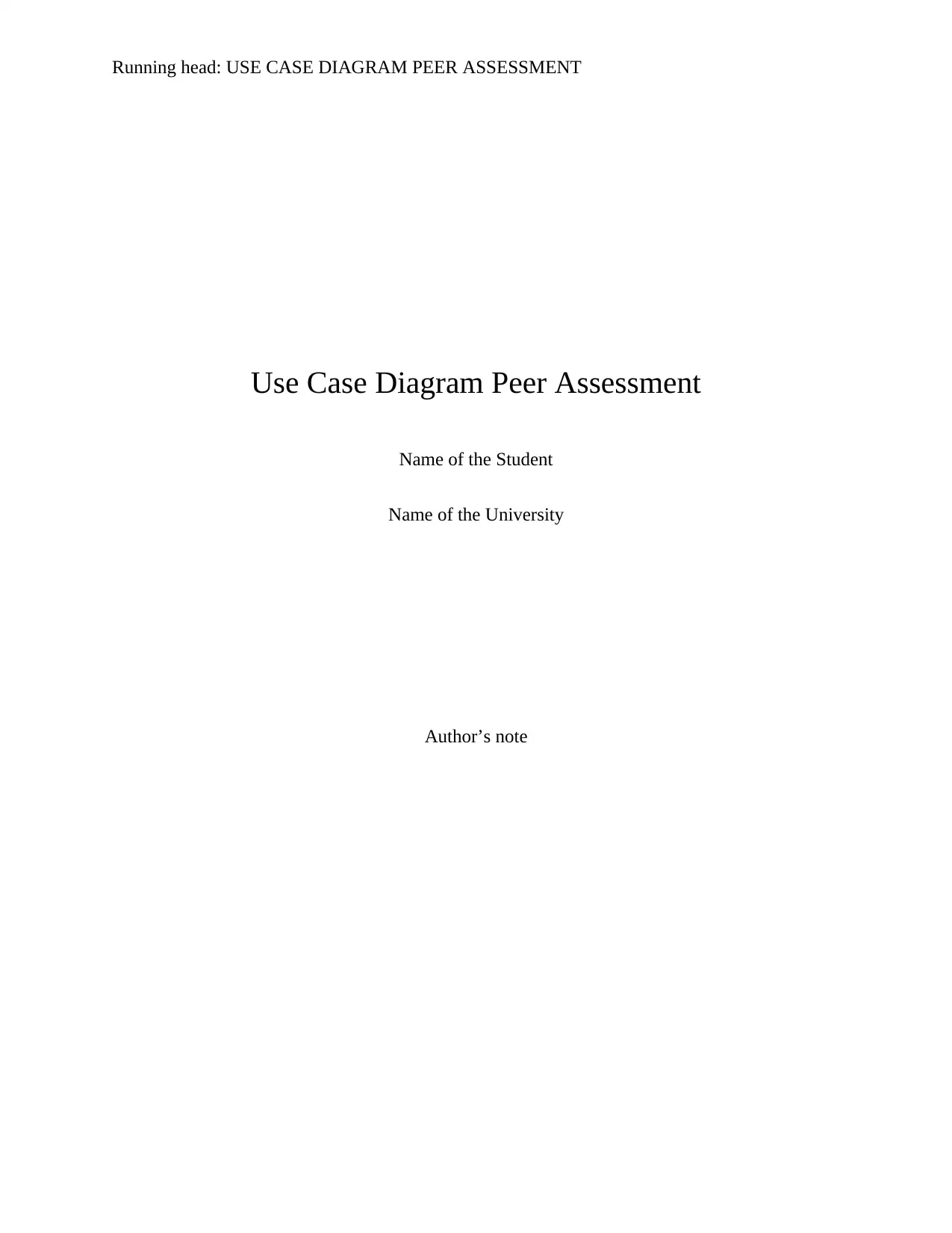
Running head: USE CASE DIAGRAM PEER ASSESSMENT
Use Case Diagram Peer Assessment
Name of the Student
Name of the University
Author’s note
Use Case Diagram Peer Assessment
Name of the Student
Name of the University
Author’s note
Paraphrase This Document
Need a fresh take? Get an instant paraphrase of this document with our AI Paraphraser
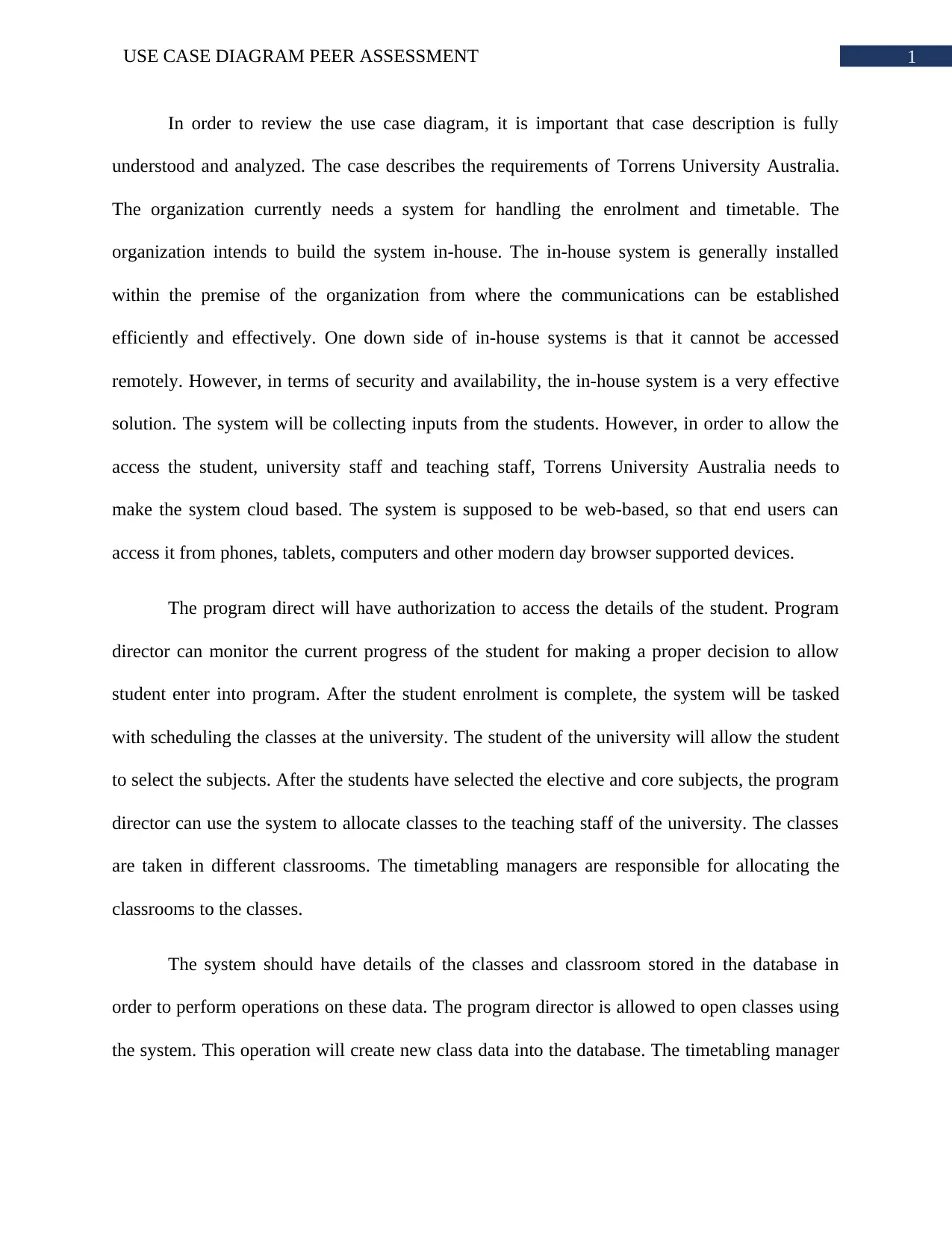
1USE CASE DIAGRAM PEER ASSESSMENT
In order to review the use case diagram, it is important that case description is fully
understood and analyzed. The case describes the requirements of Torrens University Australia.
The organization currently needs a system for handling the enrolment and timetable. The
organization intends to build the system in-house. The in-house system is generally installed
within the premise of the organization from where the communications can be established
efficiently and effectively. One down side of in-house systems is that it cannot be accessed
remotely. However, in terms of security and availability, the in-house system is a very effective
solution. The system will be collecting inputs from the students. However, in order to allow the
access the student, university staff and teaching staff, Torrens University Australia needs to
make the system cloud based. The system is supposed to be web-based, so that end users can
access it from phones, tablets, computers and other modern day browser supported devices.
The program direct will have authorization to access the details of the student. Program
director can monitor the current progress of the student for making a proper decision to allow
student enter into program. After the student enrolment is complete, the system will be tasked
with scheduling the classes at the university. The student of the university will allow the student
to select the subjects. After the students have selected the elective and core subjects, the program
director can use the system to allocate classes to the teaching staff of the university. The classes
are taken in different classrooms. The timetabling managers are responsible for allocating the
classrooms to the classes.
The system should have details of the classes and classroom stored in the database in
order to perform operations on these data. The program director is allowed to open classes using
the system. This operation will create new class data into the database. The timetabling manager
In order to review the use case diagram, it is important that case description is fully
understood and analyzed. The case describes the requirements of Torrens University Australia.
The organization currently needs a system for handling the enrolment and timetable. The
organization intends to build the system in-house. The in-house system is generally installed
within the premise of the organization from where the communications can be established
efficiently and effectively. One down side of in-house systems is that it cannot be accessed
remotely. However, in terms of security and availability, the in-house system is a very effective
solution. The system will be collecting inputs from the students. However, in order to allow the
access the student, university staff and teaching staff, Torrens University Australia needs to
make the system cloud based. The system is supposed to be web-based, so that end users can
access it from phones, tablets, computers and other modern day browser supported devices.
The program direct will have authorization to access the details of the student. Program
director can monitor the current progress of the student for making a proper decision to allow
student enter into program. After the student enrolment is complete, the system will be tasked
with scheduling the classes at the university. The student of the university will allow the student
to select the subjects. After the students have selected the elective and core subjects, the program
director can use the system to allocate classes to the teaching staff of the university. The classes
are taken in different classrooms. The timetabling managers are responsible for allocating the
classrooms to the classes.
The system should have details of the classes and classroom stored in the database in
order to perform operations on these data. The program director is allowed to open classes using
the system. This operation will create new class data into the database. The timetabling manager
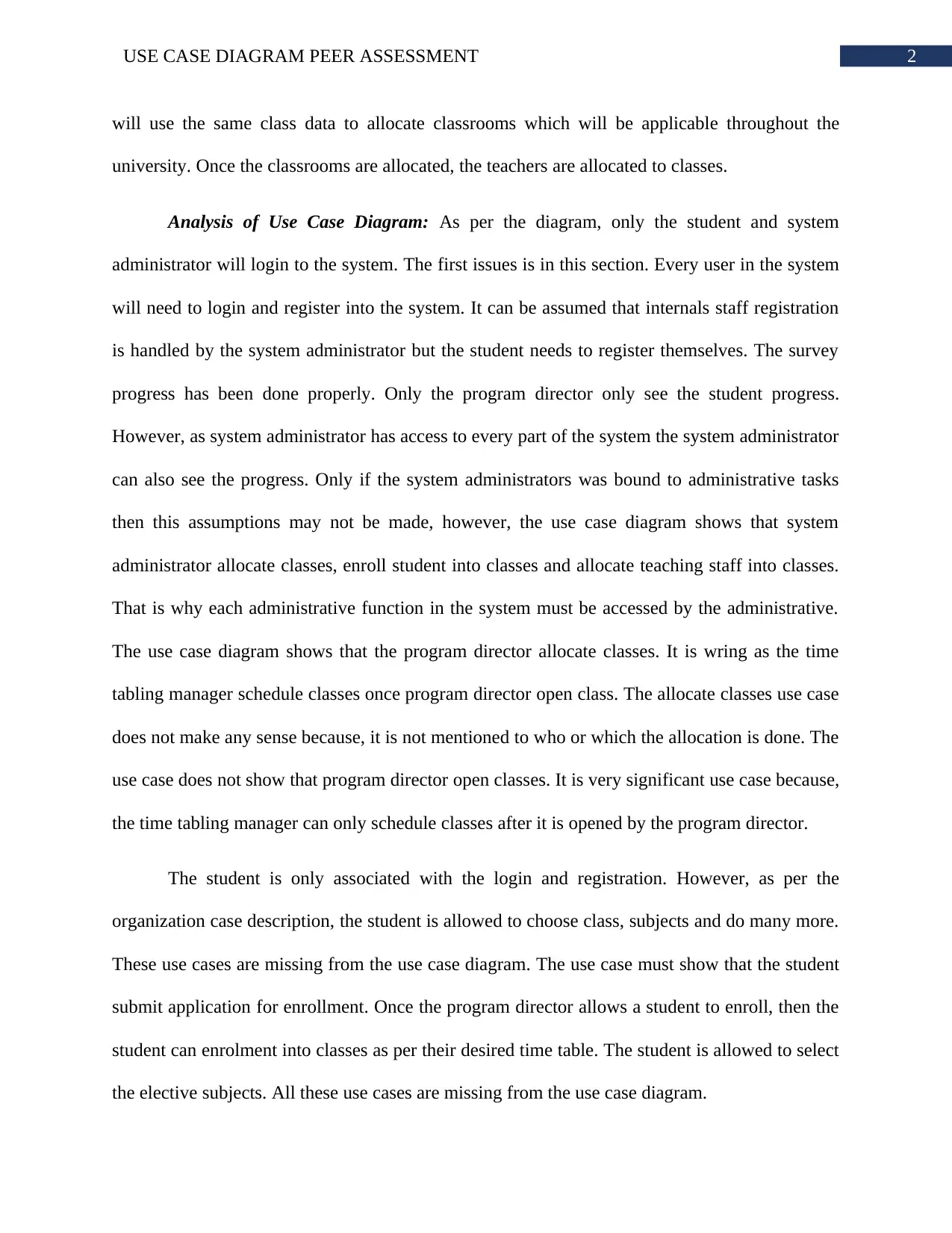
2USE CASE DIAGRAM PEER ASSESSMENT
will use the same class data to allocate classrooms which will be applicable throughout the
university. Once the classrooms are allocated, the teachers are allocated to classes.
Analysis of Use Case Diagram: As per the diagram, only the student and system
administrator will login to the system. The first issues is in this section. Every user in the system
will need to login and register into the system. It can be assumed that internals staff registration
is handled by the system administrator but the student needs to register themselves. The survey
progress has been done properly. Only the program director only see the student progress.
However, as system administrator has access to every part of the system the system administrator
can also see the progress. Only if the system administrators was bound to administrative tasks
then this assumptions may not be made, however, the use case diagram shows that system
administrator allocate classes, enroll student into classes and allocate teaching staff into classes.
That is why each administrative function in the system must be accessed by the administrative.
The use case diagram shows that the program director allocate classes. It is wring as the time
tabling manager schedule classes once program director open class. The allocate classes use case
does not make any sense because, it is not mentioned to who or which the allocation is done. The
use case does not show that program director open classes. It is very significant use case because,
the time tabling manager can only schedule classes after it is opened by the program director.
The student is only associated with the login and registration. However, as per the
organization case description, the student is allowed to choose class, subjects and do many more.
These use cases are missing from the use case diagram. The use case must show that the student
submit application for enrollment. Once the program director allows a student to enroll, then the
student can enrolment into classes as per their desired time table. The student is allowed to select
the elective subjects. All these use cases are missing from the use case diagram.
will use the same class data to allocate classrooms which will be applicable throughout the
university. Once the classrooms are allocated, the teachers are allocated to classes.
Analysis of Use Case Diagram: As per the diagram, only the student and system
administrator will login to the system. The first issues is in this section. Every user in the system
will need to login and register into the system. It can be assumed that internals staff registration
is handled by the system administrator but the student needs to register themselves. The survey
progress has been done properly. Only the program director only see the student progress.
However, as system administrator has access to every part of the system the system administrator
can also see the progress. Only if the system administrators was bound to administrative tasks
then this assumptions may not be made, however, the use case diagram shows that system
administrator allocate classes, enroll student into classes and allocate teaching staff into classes.
That is why each administrative function in the system must be accessed by the administrative.
The use case diagram shows that the program director allocate classes. It is wring as the time
tabling manager schedule classes once program director open class. The allocate classes use case
does not make any sense because, it is not mentioned to who or which the allocation is done. The
use case does not show that program director open classes. It is very significant use case because,
the time tabling manager can only schedule classes after it is opened by the program director.
The student is only associated with the login and registration. However, as per the
organization case description, the student is allowed to choose class, subjects and do many more.
These use cases are missing from the use case diagram. The use case must show that the student
submit application for enrollment. Once the program director allows a student to enroll, then the
student can enrolment into classes as per their desired time table. The student is allowed to select
the elective subjects. All these use cases are missing from the use case diagram.
⊘ This is a preview!⊘
Do you want full access?
Subscribe today to unlock all pages.

Trusted by 1+ million students worldwide
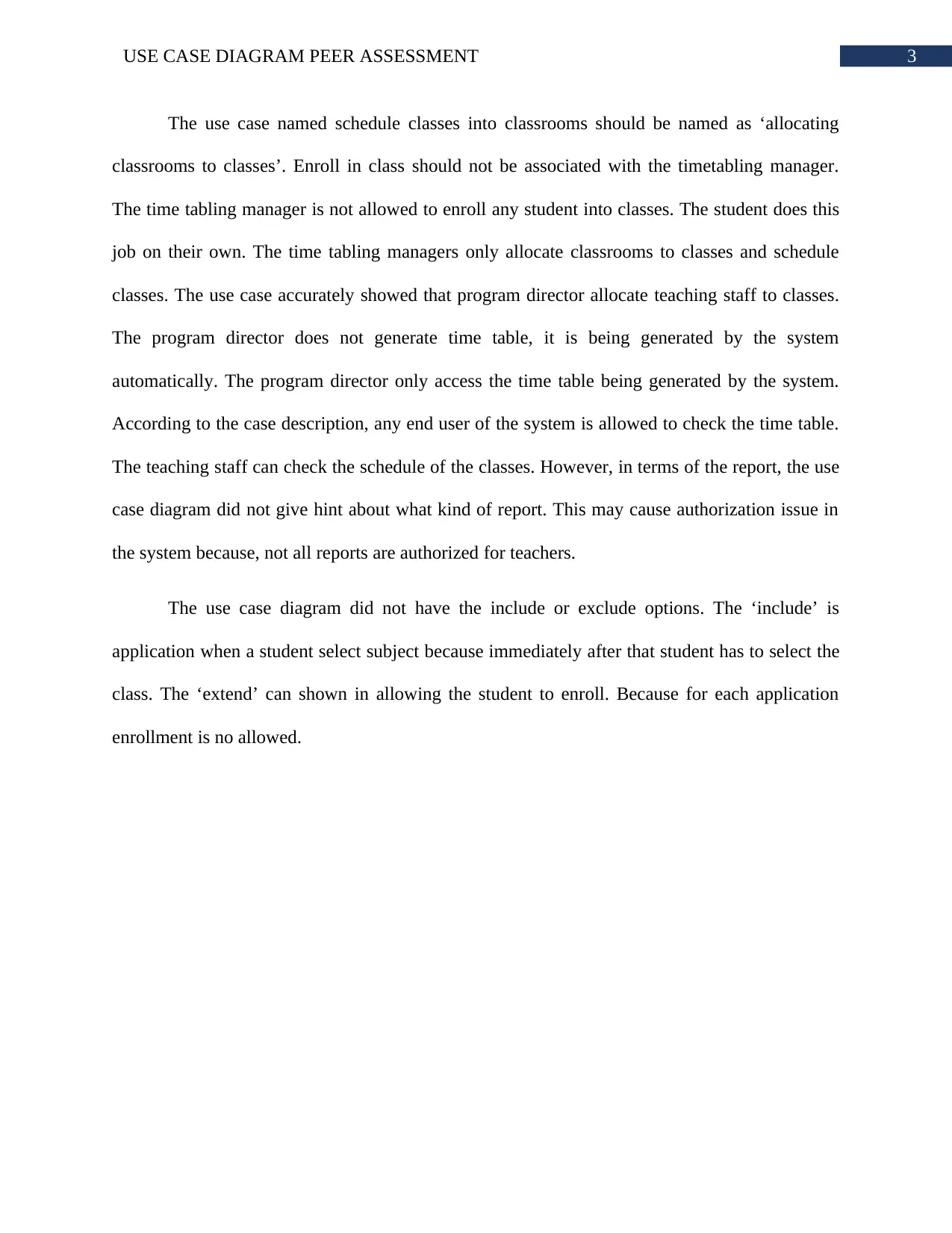
3USE CASE DIAGRAM PEER ASSESSMENT
The use case named schedule classes into classrooms should be named as ‘allocating
classrooms to classes’. Enroll in class should not be associated with the timetabling manager.
The time tabling manager is not allowed to enroll any student into classes. The student does this
job on their own. The time tabling managers only allocate classrooms to classes and schedule
classes. The use case accurately showed that program director allocate teaching staff to classes.
The program director does not generate time table, it is being generated by the system
automatically. The program director only access the time table being generated by the system.
According to the case description, any end user of the system is allowed to check the time table.
The teaching staff can check the schedule of the classes. However, in terms of the report, the use
case diagram did not give hint about what kind of report. This may cause authorization issue in
the system because, not all reports are authorized for teachers.
The use case diagram did not have the include or exclude options. The ‘include’ is
application when a student select subject because immediately after that student has to select the
class. The ‘extend’ can shown in allowing the student to enroll. Because for each application
enrollment is no allowed.
The use case named schedule classes into classrooms should be named as ‘allocating
classrooms to classes’. Enroll in class should not be associated with the timetabling manager.
The time tabling manager is not allowed to enroll any student into classes. The student does this
job on their own. The time tabling managers only allocate classrooms to classes and schedule
classes. The use case accurately showed that program director allocate teaching staff to classes.
The program director does not generate time table, it is being generated by the system
automatically. The program director only access the time table being generated by the system.
According to the case description, any end user of the system is allowed to check the time table.
The teaching staff can check the schedule of the classes. However, in terms of the report, the use
case diagram did not give hint about what kind of report. This may cause authorization issue in
the system because, not all reports are authorized for teachers.
The use case diagram did not have the include or exclude options. The ‘include’ is
application when a student select subject because immediately after that student has to select the
class. The ‘extend’ can shown in allowing the student to enroll. Because for each application
enrollment is no allowed.
Paraphrase This Document
Need a fresh take? Get an instant paraphrase of this document with our AI Paraphraser
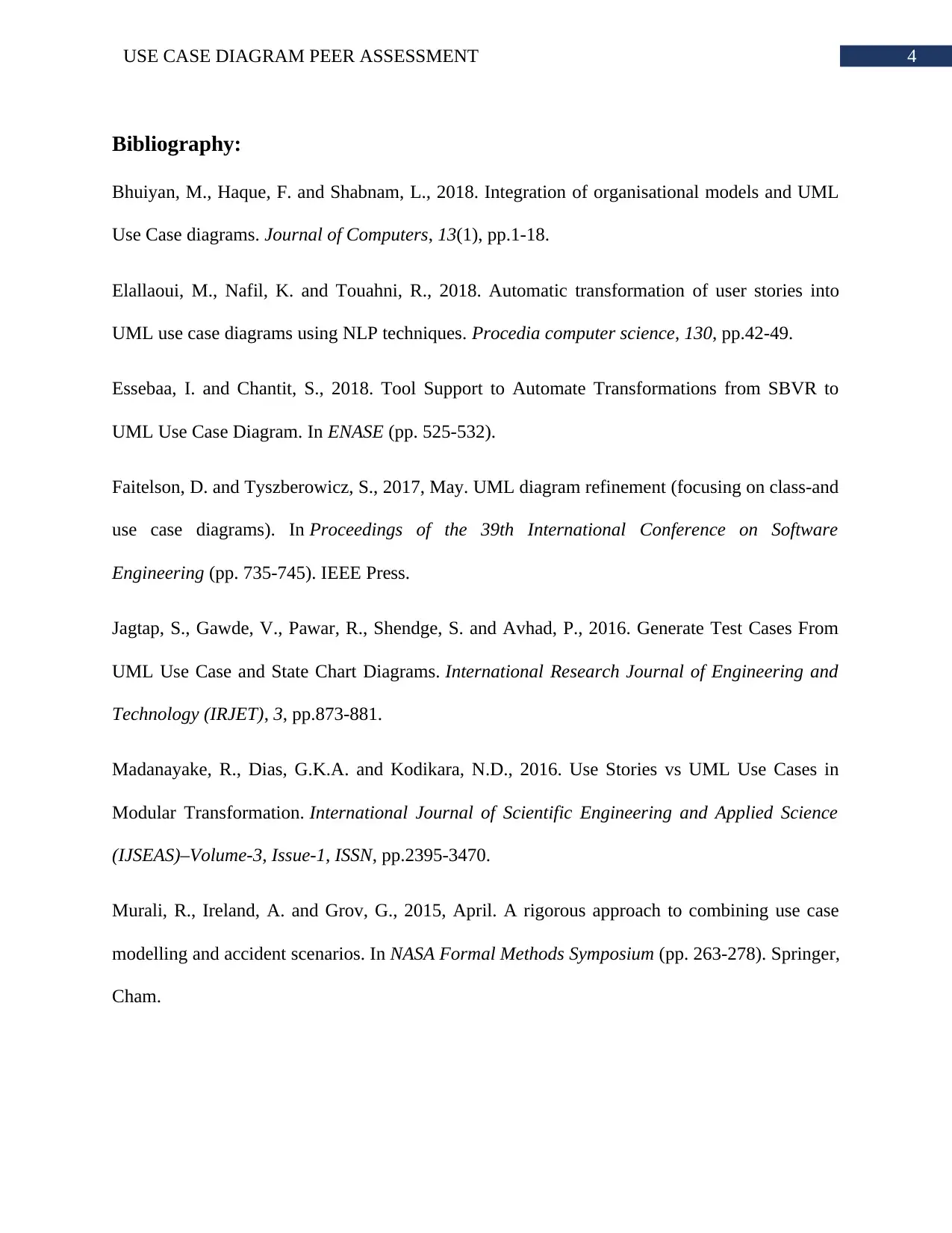
4USE CASE DIAGRAM PEER ASSESSMENT
Bibliography:
Bhuiyan, M., Haque, F. and Shabnam, L., 2018. Integration of organisational models and UML
Use Case diagrams. Journal of Computers, 13(1), pp.1-18.
Elallaoui, M., Nafil, K. and Touahni, R., 2018. Automatic transformation of user stories into
UML use case diagrams using NLP techniques. Procedia computer science, 130, pp.42-49.
Essebaa, I. and Chantit, S., 2018. Tool Support to Automate Transformations from SBVR to
UML Use Case Diagram. In ENASE (pp. 525-532).
Faitelson, D. and Tyszberowicz, S., 2017, May. UML diagram refinement (focusing on class-and
use case diagrams). In Proceedings of the 39th International Conference on Software
Engineering (pp. 735-745). IEEE Press.
Jagtap, S., Gawde, V., Pawar, R., Shendge, S. and Avhad, P., 2016. Generate Test Cases From
UML Use Case and State Chart Diagrams. International Research Journal of Engineering and
Technology (IRJET), 3, pp.873-881.
Madanayake, R., Dias, G.K.A. and Kodikara, N.D., 2016. Use Stories vs UML Use Cases in
Modular Transformation. International Journal of Scientific Engineering and Applied Science
(IJSEAS)–Volume-3, Issue-1, ISSN, pp.2395-3470.
Murali, R., Ireland, A. and Grov, G., 2015, April. A rigorous approach to combining use case
modelling and accident scenarios. In NASA Formal Methods Symposium (pp. 263-278). Springer,
Cham.
Bibliography:
Bhuiyan, M., Haque, F. and Shabnam, L., 2018. Integration of organisational models and UML
Use Case diagrams. Journal of Computers, 13(1), pp.1-18.
Elallaoui, M., Nafil, K. and Touahni, R., 2018. Automatic transformation of user stories into
UML use case diagrams using NLP techniques. Procedia computer science, 130, pp.42-49.
Essebaa, I. and Chantit, S., 2018. Tool Support to Automate Transformations from SBVR to
UML Use Case Diagram. In ENASE (pp. 525-532).
Faitelson, D. and Tyszberowicz, S., 2017, May. UML diagram refinement (focusing on class-and
use case diagrams). In Proceedings of the 39th International Conference on Software
Engineering (pp. 735-745). IEEE Press.
Jagtap, S., Gawde, V., Pawar, R., Shendge, S. and Avhad, P., 2016. Generate Test Cases From
UML Use Case and State Chart Diagrams. International Research Journal of Engineering and
Technology (IRJET), 3, pp.873-881.
Madanayake, R., Dias, G.K.A. and Kodikara, N.D., 2016. Use Stories vs UML Use Cases in
Modular Transformation. International Journal of Scientific Engineering and Applied Science
(IJSEAS)–Volume-3, Issue-1, ISSN, pp.2395-3470.
Murali, R., Ireland, A. and Grov, G., 2015, April. A rigorous approach to combining use case
modelling and accident scenarios. In NASA Formal Methods Symposium (pp. 263-278). Springer,
Cham.

5USE CASE DIAGRAM PEER ASSESSMENT
Singh, A. and Sharma, E.S., 2015. Functional Test Cases Generation Based on Automated
Generated Use Case Diagram. Chandigarh University, International Journal of Innovative
Research in Advanced Engineering (IJIRAE), 2(8).
Singh, A. and Sharma, E.S., 2015. Functional Test Cases Generation Based on Automated
Generated Use Case Diagram. Chandigarh University, International Journal of Innovative
Research in Advanced Engineering (IJIRAE), 2(8).
⊘ This is a preview!⊘
Do you want full access?
Subscribe today to unlock all pages.

Trusted by 1+ million students worldwide
1 out of 6
Related Documents
Your All-in-One AI-Powered Toolkit for Academic Success.
+13062052269
info@desklib.com
Available 24*7 on WhatsApp / Email
![[object Object]](/_next/static/media/star-bottom.7253800d.svg)
Unlock your academic potential
Copyright © 2020–2025 A2Z Services. All Rights Reserved. Developed and managed by ZUCOL.





